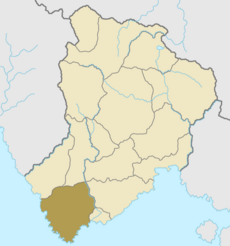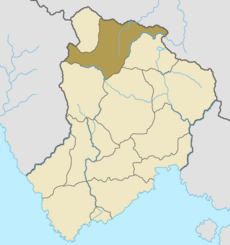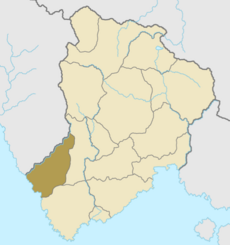Gotneska
Second Kingdom of Gotneska Annað Konungsríki af Gotneska Dara Ríocht na Gotach | |
|---|---|
| Motto: "Sanngirni Guðs sem við trúum" Fairness of God We Believe | |
| Anthem: "Ri undioir fjallinu" | |
 Map of Gotneska | |
| Capital | Læniguëuíl |
| Largest | Dunshaughlin |
| Official languages | Götaish |
| Recognised national languages | Meallángan |
| Ethnic groups | Götani 35% Máellái 33% Nanuvat 2% Ruaí 5% Ateenian Aurivizh Densëhars 2% Ulfan |
| Demonym(s) | Goutian |
| Government | Constitutional-Parliamentary Monarchy |
• Monarch | Sarah II |
• Prime Minister | Askur Karlsson |
• Deputy Prime Minister | Olfúr Andersson |
• Speaker of the Riksdag | Erik Magnússon |
| Legislature | Riksdag |
| Establishment | |
• Cordic Peoples migrate | 2500 BC |
| 670-1290 | |
| Area | |
• | 349,700 km2 (135,000 sq mi) |
| Population | |
• 2020 estimate | 19,747,689 |
• Density | 56.5/km2 (146.3/sq mi) |
| GDP (nominal) | 2022 estimate |
• Total | 276.467 billion |
| Gini (2020) | 26.8 low |
| HDI (2020) | 0.93 very high |
| Time zone | UTC+1 (WAT) |
• Summer (DST) | UTC+2 (WAST) |
| Date format | dd-mm-yyyy (AD) |
| Driving side | right |
| Calling code | +25 |
| Internet TLD | .ga |
This section is actively undergoing a major edit for a short while. To help avoid edit conflicts, please do not edit this section while this message is displayed. This page was last edited at 05:48, 1 August 2022 (UTC) (2 years ago). Please remove this template if this page hasn't been edited in several hours. If you are the editor who added this template, please be sure to remove it or replace it with {{Under construction}} between editing sessions. |
The Second Kingdom of Gotneska, commonly known as Gotaland (Götaish: Konungsríki Gotneska, and widely known just as Gotneska), is a sovereign nation and Constitutional-Parliamentary Monarchy in Argis on Eurth. The country shares a border is with Ulfhemir to the west and Aurivizh to the east. Both borders are created by rivers. The country also has about 19.5 million citizens.
History
The history of Gotneska as a unified kingdom began in the 9th century. However, historic documents describe the geographic area and the people living there, the Götaí and Ruaíaí, as early as 500 CE. These early documents include the writings of ?? and ??. With the Christianization of the Geats circa 660s AD, it is clear that there existed a kingship. Queen Sarah II can trace her lineage back to the Cordic & Namór Ásásadóirmenni kings ?? and ?? from this time, thus making the Monarchy of Gotneska one of the oldest continues bloodlines in Argis. The area now known as Gotneska has a rich prehistory, having been populated by several prehistoric cultures and people for about 10,500 to 8,000 years, since the end of the last ice age. But the first evidence of human presence in Gotneska is much earlier, dating to around 45,000 years ago.
Geography
Gotneska is located on the western half of the yeetland peninsula. It is border by Aurivizh to the southeast, and Ulfheimr to the west. Most of the nation is south of the Argic Circle, but a small portion lays north of it, one of the largest settlements lays 10 km North of the city. The nation has serval small islands off its coast. The country lies between latitudes 59 and 70°N, and longitudes 14 and 10°W. The most notable topographical features of the country are the Kendovstrunmahhe Mountains, Aurum Coast. The Gotneskan Kendovstrunmahhes are located mainly within the Járnger Ðr, the highest point is Skaðifjall, at 5,785 m (18,980 ft). And the lowest point would be sea level 0 m. Gotneska also has five major rivers, two of which help create it borders.
The River Bóanau, Located in Aibhneacha Móra NP.
Aerial view of Saint Áine Monastery, Cordic Isles.
Flora
Fauna
Climate
Environment
Administrative divisions
The bureaucratic administration of Gotneksa is divided into four basic levels. Following the Nomenclature of Territorial Units for Statistics (NUTS), these levels are: country, region (NUTS-1), province (NUTS-2), and municipality (LAU). Below the national government, there are 4 regions, further divided into 16 provinces and then 42 counties.
PoliticsGovernmentBig Four of Gotneska Politics in Gotneska operate under a framework laid out in the Constitution of Gotneska. First written in 1849, it establishes a sovereign state in the form of a constitutional monarchy, with a representative parliamentary system. The monarch officially retains executive power and presides over the Council of State (privy council). The monarch has full executive power which they can use to a limit some other things they can are such as the formal appointment and dismissal of the Prime Minister and other Government ministers. The Monarch is not answerable for his or her actions, and their person is sacrosanct. Hereditary monarch Queen Sarah II has been head of state since 10 October 2017. Foreign relationsMilitaryEconomyEnergyIndustryInfrastructureTransportDemographicsEducationReligionReligion in Gotneska Catholic Church (70%) Protestant (15%) Vjöldism (7%) Neo-Cordic (5%) Old Norse (3%)
Religious freedom is constitutionally provided for in Gotneska, and the country's constitution had been secular from 1969 to 1973. Christianity is the predominant religion, and while Gotneska remains a predominantly Catholic country, the percentage of the population who identified as Catholic on the census has fallen sharply from 87.2 percent in the 2011 census to 84.3 percent in the most recent 2019 census. Other results from the 2019 census are: 6.7% Protestant, 5.2% Neopagan, and 4.2% as having no religion. Gotneska's patron saints are Saint Áine, Saint Palmer, Saint Brendan and Saint Arvid.. Saint Áine & Palmer are the only ones commonly recognised as the patron saint. Saint Áine's Day is celebrated on 18 March in Gotneska and abroad as the Gotneskan national day. Will Saint Palmer's Day is celebrated on 2nd April. Both days have parades and other celebrations. CultureMusic and ArtArtMusicMost Gotneskan music is related to Cordic or TBD name, and includes folk and pop traditions. Notable Gotneskan music acts include medieval music group Nafoíne Guth, and the Cordic Women. Famous singers from this group include; Gráinne Ó Gallchobhair. CuisinePopular everyday beverages among the Gotneskan’s include tea and coffee. Alcoholic drinks associated with Gotneska include wurld-famous Bronaugh, which is an amber ale/stout that originated in the brewery of Patrick Bronaugh at St. Áine's Gate in Sionainn. SportsThe most popular team sports in Gotneska are Hockey, Football, and finally Rugby. Hockey is by far the more popular but is also the less successful in international competition. Football is second when it comes to international wins only behind Rugby which has been able to keep a pretty consistent ranking in the Top 10. |
|||||||||||||||||||||||||||||||||||||||||||||||||||||||||||||||
















